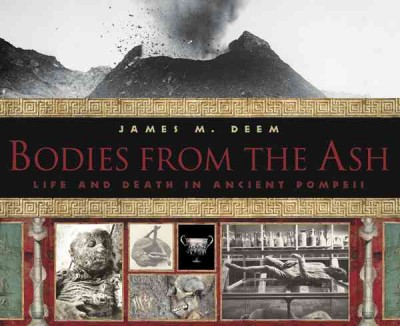| Bodies from the Ash: Life and Death in Ancient Pompeii Contributor(s): Deem, James M. (Author) |
|
 |
ISBN: 0618473084 ISBN-13: 9780618473083 Publisher: Clarion Books OUR PRICE: $15.29 Product Type: Hardcover - Other Formats Published: October 2005 * Not available - Not in print at this time *Annotation: In ancient times, Pompeii was one of the largest cities in the Roman Empire. Its 20,000 inhabitants lived in the shadow of Vesuvius, which they believed was nothing more than a mountain. But Vesuvius was a volcano. And on the morning of August 24, A.D. 79, Vesuvius began to erupt. Within twenty-four hours, the entire city of Pompeii--and many of its citizens--had been utterly annihilated. It was not until hundreds of years later that Pompeii saw daylight again, as archaeological excavations began to unearth what had been buried under layers of volcanic rubble. Digging crews expected to find buildings and jewelry and other treasures, but they found something unexpected, too: the imprints of lost Pompeiians, their deaths captured as if by photographic images in volcanic ash. |
| Additional Information |
| BISAC Categories: - Juvenile Nonfiction | History - Ancient - Juvenile Nonfiction | History - Europe - Juvenile Nonfiction | Science & Nature - Earth Sciences - Earthquakes & Volcanoes |
| Dewey: 937.7 |
| LCCN: 2004026553 |
| Lexile Measure: 1120 |
| Physical Information: 0.6" H x 11.2" W x 9.1" (1.15 lbs) 64 pages |
| Themes: - Chronological Period - Ancient (To 499 A.D.) - Cultural Region - Italy |
| Accelerated Reader Info |
| Quiz #: 103280 Reading Level: 8.0 Interest Level: Middle Grades Point Value: 1.0 |
| Descriptions, Reviews, Etc. |
| Publisher Description: In ancient times, Pompeii was one of the largest cities in the Roman Empire. Its 20,000 inhabitants lived in the shadow of Vesuvius, which they believed was nothing more than a mountain. But Vesuvius was a volcano. And on the morning of August 24, A.D. 79, Vesuvius began to erupt. Within twenty-four hours, the entire city of Pompeii--and many of its citizens--had been utterly annihilated. It was not until hundreds of years later that Pompeii saw daylight again, as archaeological excavations began to unearth what had been buried under layers of volcanic rubble. Digging crews expected to find buildings and jewelry and other treasures, but they found something unexpected, too: the imprints of lost Pompeiians, their deaths captured as if by photographic images in volcanic ash. |
Contributor Bio(s): Deem, James M.: - James M. Deem is the author of numerous books for young readers, including 3 NB of Julian Drew, Bodies from the Ice: Melting Glaciers and the Rediscovery of the Past, and Faces From the Past. Mr. Deem lives outside of Phoenix, Arizona. |